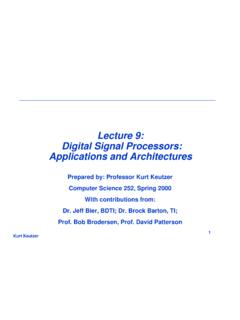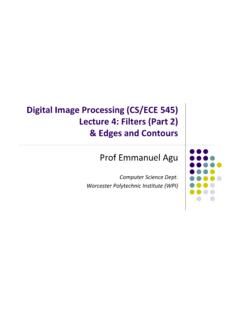Transcription of SigmaDSP Digital Audio Processor Data Sheet …
1 SigmaDSP Digital Audio ProcessorData Sheet ADAU1462/ADAU1466 Rev. C Document Feedback Information furnished by Analog Devices is believed to be accurate and reliable. However, no responsibility is assumed by Analog Devices for its use, nor for any infringements of patents or other rights of third parties that may result from its use. Specifications subject to change without notice. No license is granted by implication or otherwise under any patent or patent rights of Analog Devices. Trademarks and registered trademarks are the property of their respective owners. One Technology Way, Box 9106, Norwood, MA 02062-9106, : 2017 2018 Analog Devices, Inc. All rights reserved. Technical Support FEATURES Qualified for automotive applications Fully programmable Audio DSP for enhanced sound processing Features SigmaStudio, a proprietary graphical programming tool for the development of custom signal flows Up to MHz, 32-bit SigmaDSP core at V Up to 24 kWords of program memory Up to 80 kWords of parameter/data RAM Up to 6144 SIMD instructions per sample at 48 kHz Up to 1600 ms Digital Audio delay pool at 48 kHz Audio I/O and routing 4 serial input ports, 4 serial output ports 48-channel, 32-bit Digital I/O up to a sample rate of 192 kHz Flexible configuration for TDM, I2S, left and right justified formats, and PCM Up to 8 stereo ASRCs from 1:8 up to.
2 1 ratio and 139 dB dynamic range Stereo S/PDIF input and output at 192 kHz Four PDM microphone input channels Multichannel, byte addressable TDM serial ports Clock oscillator for generating master clock from crystal Integer PLL and flexible clock generators Integrated die temperature sensor I2C and SPI control interfaces (both slave and master) Standalone operation Self-boot from serial EEPROM 6-channel, 10-bit SAR auxiliary control ADC 14 multipurpose pins for Digital controls and outputs On-chip regulator for generating V from V supply 72-lead, 10 mm 10 mm LFCSP package with mm exposed pad Temperature range: 40 C to +105 C APPLICATIONS Automotive Audio processing Head units Distributed amplifiers Rear seat entertainment systems Trunk amplifiers Commercial and professional Audio processing FUNCTIONAL BLOCK DIAGRAM S/PDIFTRANSMITTERS/PDIFRECEIVER8 2-CHANNELASYNCHRONOUSSAMPLE RATECONVERTERSINPUTCLOCKDOMAINS( 4)OUTPUTCLOCKDOMAINS( 4)CLOCKOSCILLATORGPIO/AUX ADCPLLI2C/SPISLAVEXTALIN/MCLKXTALOUTSPI/ I2C*BCLK_IN3 TO BCLK_IN0/LRCLK_IN3 TO LRCLK_IN0(INPUT CLOCK PAIRS)SELFBOOTSPDIFINSPDIFOUTCLKOUTSDATA _IN3 TO SDATA_IN0(48-CHANNELDIGITAL AUDIOINPUTS)SDATA_OUT3 TO SDATA_OUT0(48-CHANNELDIGITAL AUDIOOUTPUTS)REGULATORADAU1462/ADAU1466 PLLFILTMP13 TO MP0 AUXADC5 TOAUXADC0 BCLK_OUT3 TO BCLK_OUT0 LRCLK_OUT3 TO LRCLK_OUT0(OUTPUT CLOCK PAIRS)TEMPERATURESENSORTHD_PVDRIVETHD_MI 2C/SPIMASTERSPI/I2C*DIGITALMIC INPUTSERIAL DATAINPUT PORTS( 4)
3 SERIAL DATAOUTPUT PORTS( 4)DEJITTER ANDCLOCK GENERATORINPUT AUDIOROUTING MATRIXOUTPUT AUDIOROUTING AUDIOPROCESSING CORERAM, ROM, WATCHDOG,MEMORY PARITY CHECK14810-001*SPI/I2C INCLUDES THE FOLLOWING PIN FUNCTIONS: SS_M, MOSI_M, SCL_M, SCLK_M, SDA_M, MISO_M, MISO, SDA, SCLK, SCL, MOSI, ADDR1, SS, AND ADDR0 PINS. Figure 1. ADAU1462/ADAU1466 Data Sheet Rev. C | Page 2 of 202 TABLE OF CONTENTS Features .. 1 Applications .. 1 Functional Block Diagram .. 1 Revision History .. 3 General Description .. 4 Differences Between the ADAU1466 and ADAU1462 .. 4 Specifications .. 5 Electrical Characteristics .. 7 Timing Specifications .. 9 Absolute Maximum Ratings .. 17 Thermal Considerations .. 17 ESD Caution .. 17 Pin Configuration and Function Descriptions .. 18 Theory of Operation .. 22 System Block Diagram .. 22 Overview .. 22 Initialization.
4 24 Master Clock, PLL, and Clock 28 Power Supplies, Voltage Regulator, and Hardware Reset .. 33 Temperature Sensor 34 Slave Control Ports .. 35 Slave Control Port Addressing .. 35 Slave Port to DSP Core Address Mapping .. 36 Master Control Ports .. 44 Self Boot .. 45 Audio Signal Routing .. 48 Serial Data 57 Flexible TDM Interface .. 68 Asynchronous Sample Rate Converters .. 74 S/PDIF Interface .. 74 Digital PDM Microphone Interface .. 76 Multipurpose Pins .. 77 Auxiliary ADC .. 80 SigmaDSP Core .. 80 Software Features .. 86 Pin Drive Strength, Slew Rate, and Pull Configuration .. 87 Global RAM and Control Register Map .. 89 Random Access Memory .. 89 Control Registers .. 92 Control Register Details .. 98 PLL Configuration Registers .. 98 Clock Generator Registers .. 103 Power Reduction Registers .. 108 Audio Signal Routing Registers.
5 111 Serial Port Configuration Registers .. 117 Flexible TDM Interface Registers .. 121 DSP Core Control Registers .. 124 Debug and Reliability Registers .. 129 Software Panic Value 0 Register .. 136 Software Panic Value 1 Register .. 136 DSP Program Execution Registers .. 139 Panic Mask Registers .. 142 Multipurpose Pin Configuration 155 ASRC Status and Control Registers .. 160 Auxiliary ADC Registers .. 164 S/PDIF Interface Registers .. 165 Hardware Interfacing Registers .. 178 Soft Reset Register .. 196 Applications Information .. 197 PCB Design Considerations .. 197 Typical Applications Block Diagram .. 199 Example PCB Layout .. 200 PCB Manufacturing Guidelines .. 201 Outline Dimensions .. 202 Ordering Guide .. 202 Automotive Products .. 202 Data Sheet ADAU1462/ADAU1466 Rev. C | Page 3 of 202 REVISION HISTORY 3/2018 Rev. B to Rev.
6 C Changes to Table 1 .. 4 Changes to Table 2 .. 5 Changes to Table 3 .. 6 Added Endnote 1, Table 6 .. 9 Deleted Endnote 1, Table 9 .. 11 Changes to S/PDIF Transmitter and Receiver Section and Table 10 .. 11 Deleted S/PDIF Receiver Section and Table 11; Renumbered Sequentially .. 11 Added Table 11; Renumbered Sequentially .. 12 Added I2C Interface Master Section .. 13 Changes to Table 20 .. 29 Changes to Table 21 .. 30 Changes to SigmaDSP Core Section .. 80 Changes to Ordering Guide ..202 10/2017 Rev. A to Rev. B Changes to Table 1 .. 4 Changes to Table 2 .. 5 Changes to Table 3 .. 6 Changes to Table 6 .. 9 Changes to Table 21 .. 29 Changes to PLL filter Section and Table 22 .. 30 Changes to Clock Generators Section and Figure 18 .. 31 Changes to Figure 19 .. 32 Changes to Figure 26 .. 37 Changes to Figure 27 .. 38 Changes to SigmaDSP Core Section.
7 80 Changes to Table 58 .. 89 Changes to Figure 82 .. 90 Changes to Figure 83 .. 91 Changes to Ordering Guide .. 202 9/2017 Rev. 0 to Rev. A Change to Supply Current Analog Current (AVDD) Parameter, Table 2 .. 4 Change to Supply Current PLL Current (PVDD) Parameter and Supply Current Analog Current (AVDD) Parameter, Table 3 .. 5 Added Endnote 2 to Ordering Guide .. 201 8/2017 Revision 0: Initial Version ADAU1462/ADAU1466 Data Sheet Rev. C | Page 4 of 202 GENERAL DESCRIPTION The ADAU1462/ADAU1466 are automotive qualified Audio processors that far exceed the Digital signal processing capabilities of earlier SigmaDSP devices. They are pin and register compatible with each other, as well as with the ADAU1450/ADAU1451/ADAU1452 SigmaDSP processors. The restructured hardware architecture is optimized for efficient Audio processing. The Audio processing algorithms support a seamless combination of stream processing (sample by sample), multirate processing, and block processing paradigms.
8 The SigmaStudio graphical programming tool enables the creation of signal processing flows that are interactive, intuitive, and powerful. The enhanced Digital signal Processor (DSP) core architecture enables some types of Audio processing algorithms to be executed using significantly fewer instructions than were required on previous SigmaDSP generations, leading to vastly improved code efficiency. The V, 32-bit DSP core can run at frequencies of up to MHz and execute up to 6144 SIMD instructions per sample at the standard sample rate of 48 kHz. Powerful clock generator hardware, including a flexible phase-locked loop (PLL) with multiple fractional integer outputs, supports all industry standard Audio sample rates. Nonstandard rates over a wide range can generate up to 15 sample rates simultaneously. These clock generators, along with the on board asynchronous sample rate converters (ASRCs) and a flexible hardware Audio routing matrix, make the ADAU1462/ADAU1466 ideal Audio hubs that greatly simplify the design of complex multirate Audio systems.
9 The ADAU1462/ADAU1466 interface with a wide range of analog-to- Digital converters (ADCs), Digital -to-analog converters (DACs), Digital Audio devices, amplifiers, and control circuitry with highly configurable serial ports, I2C, serial peripheral interface (SPI), Sony/Philips Digital Interconnect Format (S/PDIF) interfaces, and multipurpose input/output (I/O) pins. Dedicated decimation filters can decode the pulse code modulation (PDM) output of up to four MEMS microphones. Independent slave and master I2C/SPI control ports allow the ADAU1462/ADAU1466 to be programmed and controlled by an external master device such as a microcontroller, and to program and control slave peripherals directly. Self boot functionality and the master control port enable complex standalone systems. The power efficient DSP core can execute at high computational loads while consuming only a few hundred milliwatts (mW) in typical conditions.
10 This relatively low power consumption and small footprint make the ADAU1462/ADAU1466 ideal replacements for large, general-purpose DSPs that consume more power at the same processing load. Note that throughout this data Sheet , multifunction pins, such as SS_M/MP0, are referred to either by the entire pin name or by a single function of the pin, for example, MP0, when only that function is relevant. DIFFERENCES BETWEEN THE ADAU1466 AND ADAU1462 The three variants of this device are differentiated by memory and DSP core frequency. A detailed summary of the differences is listed in Table 1. Table 1. Product Selection Table Device Data Memory (kWords) Program Memory (kWords) DSP Core Frequency (MHz) ADAU1462 WBCPZ300 48 16 ADAU1462 WBCPZ150 48 16 ADAU1466 WBCPZ300 80 24 Data Sheet ADAU1462/ADAU1466 Rev.














